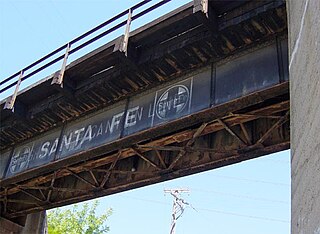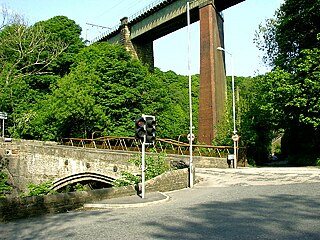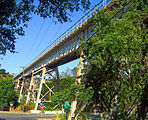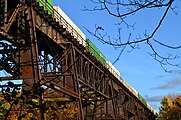
A plate girder bridge is a bridge supported by two or more plate girders.

Barmouth Bridge, or Barmouth Viaduct is a Grade II* listed single-track wooden railway viaduct across the estuary of the Afon Mawddach near Barmouth, Wales. It is 820 metres (900 yd) long and carries the Cambrian Line. It is the longest timber viaduct in Wales and one of the oldest in regular use in Britain.

Camas Prairie Railroad Company was a short line railroad in northern Idaho jointly owned and operated by Northern Pacific Railway and Union Pacific. The Camas Prairie Railroad was known as the "railroad on stilts" due to the many wooden trestles along its route.

The Cornwall Railway company constructed a railway line between Plymouth and Truro in the United Kingdom, opening in 1859, and extended it to Falmouth in 1863. The topography of Cornwall is such that the route, which is generally east–west, cuts across numerous deep river valleys that generally run north–south. At the time of construction of the line, money was in short supply due to the collapse in confidence following the railway mania, and the company sought ways of reducing expenditure.

The Loughor railway viaduct carries the West Wales Line across the River Loughor. It is adjacent, and runs parallel to, the Loughor road bridge. The 1880 viaduct was granted Grade II listed building status. Before it was demolished in early 2013, the viaduct was the last remaining timber viaduct designed by Isambard Kingdom Brunel.
The Aberystwith and Welsh Coast Railway was a standard gauge railway company, running a line along the west coast of Wales.

The original Maroon Creek Bridge is a steel trestle along State Highway 82 at the western boundary of Aspen, Colorado, United States. It was designed by George S. Morison in 1888 for the Colorado Midland Railroad, one of the last viaducts in Colorado built for a standard gauge mountain railroad in the 19th century. Of the five steel bridges the Midland built, it is the only one still extant. Due to the later removal of most track and the rail depots, the bridge is the most visible remnant of rail service to Aspen. In 1985 it was listed on the National Register of Historic Places along with other highway bridges in the state, including the Sheely Bridge, also in Aspen.

The Kinzua Bridge or the Kinzua Viaduct was a railroad trestle that spanned Kinzua Creek in McKean County in the U.S. state of Pennsylvania. The bridge was 301 feet (92 m) tall and 2,052 feet (625 m) long. Most of its structure collapsed during a tornado in July 2003.

The Pile–Pontoon Railroad Bridge was a floating bridge which crossed the Mississippi River in northern Iowa.

The Wilmington Rail Viaduct is a series of fills and bridges, about 4 miles (6.4 km) long, that carries the Northeast Corridor through the city of Wilmington, Delaware, above street level. Constructed between 1902 and 1908, the structure consists principally of fills supported by heavy stone retaining walls, punctuated with plate girder bridges over streets, and augmented by a few sections of brick arch viaduct. Its construction is typical of the Pennsylvania Railroad's architectural practices at the time, and the viaduct has been documented by the Historic American Engineering Record and listed on the National Register of Historic Places. Built by the Pennsylvania Railroad (PRR) as part of a series of grade crossing eliminations along the Northeast Corridor, the elevation of the rail line necessitated several other changes to rail infrastructure in Wilmington, including the construction of the Wilmington Shops at the east end of the viaduct, and the construction of the Wilmington Station and adjacent Pennsylvania Railroad Office Building along the elevated right-of-way.

The Tulip Viaduct is a 2,295-foot (700 m) long railroad bridge in Greene County, Indiana, that spans Richland Creek between Solsberry and Tulip. According to Richard Simmons and Francis Haywood Parker, authors of Railroads of Indiana, it is "easily the state's most spectacular railroad bridge". The bridge was built in 1905 and 1906 by the Indianapolis Southern Railway and successor Indianapolis Southern Railroad, which became part of the Illinois Central Railroad in 1911. It is now part of the Indianapolis–Newton, Illinois, line of the Indiana Rail Road.

Stoney Creek Bridge is a Canadian Pacific Railway (CP) truss arch in southeastern British Columbia. This single-track crossing over Stoney Creek is in Glacier National Park, between Revelstoke and Golden.

The Little Pipe Creek bridge and viaduct is a 705-foot (215 m) continuous truss bridge with main span and 19 viaduct sections as well as an active railroad trestle crossing Little Pipe Creek south of Keymar, Maryland. Originally constructed by the Frederick and Pennsylvania Line Railroad Company (F&PL). Construction on the trestle began in late 1871, and continued until April 1872.

In structural engineering, a trestle support is a structural element with rigid beams forming the equal sides of two parallel isosceles triangles, joined at their apices by a plank or beam. Sometimes additional rungs are stretched between the two beams. A pair of trestle legs can support one or several boards or planks, forming a trestle table or trestle desk. A network of trestle supports can serve as the framework for a trestle bridge, and a trestle of appropriate size to hold wood for sawing is known as a sawhorse.

Meldon Viaduct carried the London & South Western Railway (LSWR) across the West Okement River at Meldon on Dartmoor in Devon, South West England. The truss bridge, which was constructed from wrought iron and cast iron not stone or brick arches, was built under the direction of the LSWR's chief engineer, WR Galbraith. After taking three years to build, the dual-tracked bridge opened to rail traffic in 1874. Usage was limited to certain classes of locomotive because the viaduct had an axle load limit. Although regular services were withdrawn in 1968, the bridge was used for shunting by a local quarry. In the 1990s the remaining single line was removed after the viaduct was deemed to be too weak to carry rail traffic.

Broadbottom Viaduct is a railway viaduct that spans the River Etherow between Derbyshire and Greater Manchester in England. Originally of wooden construction supported by stone piers, the timber was replaced first with wrought iron box girders, less than 20 years after the viaduct's opening, later followed by steel trusses and more supporting piers.

Saltwater Creek Railway Bridge is a heritage-listed railway bridge over Bundaberg Creek on Quay Street from Bundaberg Central to Bundaberg East in Bundaberg, Bundaberg Region, Queensland, Australia. It was built in 1894 by James Overend. It is also known as Millaquin Bridge. It was added to the Queensland Heritage Register on 21 October 1992.

Splitters Creek Railway Bridge is a heritage-listed railway bridge across Splitters Creek on the Bundaberg - Mount Perry Line, between Oakwood and Sharon in the Bundaberg Region, Queensland, Australia. It was built from 1879 to 1880 by J & A Overend. It was added to the Queensland Heritage Register on 21 October 1992.

The Surtees Rail Bridge is a rail bridge on the Tees Valley Line over the River Tees in the Borough of Stockton-on-Tees. The bridge is south of Stockton-on-Tees town centre and just north of the adjacent Surtees Bridge which carries the A66 road. The bridge is built on the site of a series of Tees Bridges alternating between two adjacent crossing sites.





























